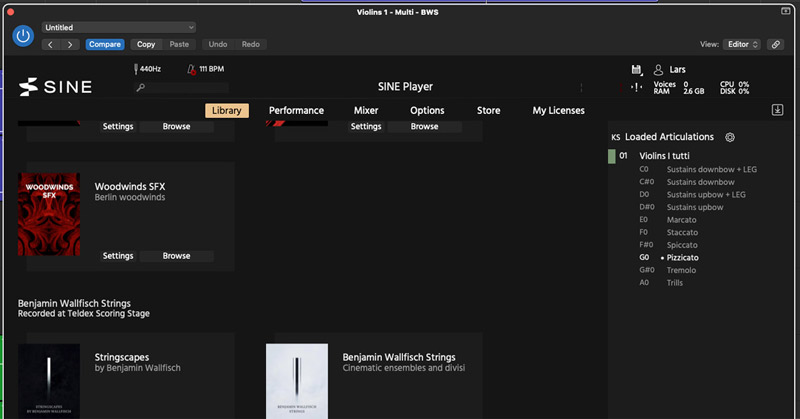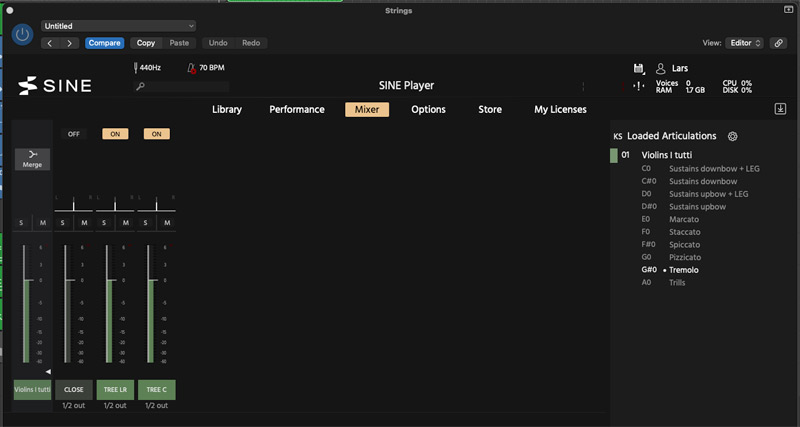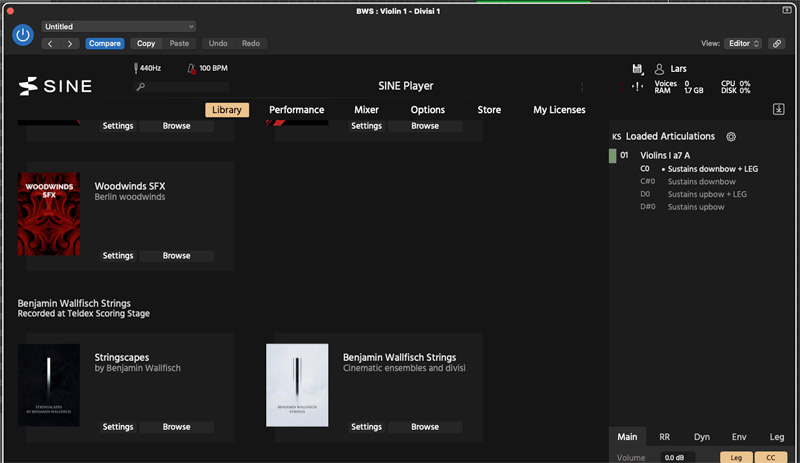Orchestral Tools Benjamin Wallfisch Strings
Modern Scoring Strings With Non-Looped Legatos
Author: Lars Deutsch
“Benjamin Wallfisch Strings” (we will use „BWS“) and “Stringscapes by Benjamin Wallfisch” are releases end of 2023 for Orchestral Tools‘ own Sine Player. Orchestral Tools is from the south of Germany, but very much associated with Berlin, for their Berlin series that is recorded at the Teldex Studio in Berlin. The libraries can be purchased separately or as a bundle.
The concept of this bundle is to capture the Benjamin Wallfisch sound and to give him the library he always wanted. Another way to view this library is as Orchestral Tools‘ version of a modern scoring string library that is more direct or moves one closer to the players.
Overview
The Sine Player is available for MacOS 10.13 or higher and Windows 10 or higher as standalone software, VST, VST3, AU and AAX. If one were to download every single microphone and option, the full bundle contains 1.2TByte of samples which take up 561GByte in the SINEarc sample format on the hard disk. For most users this is not necessary and this library can be used with a smaller footprint by installing their “basic kit”.
Installing BWS is easy in the Sine Player. I am excited that BWS has an Atmos configuration and that it offers the fully treated Benjamin Wallfisch sound, as well as raw files of everything. I am looking forward to a native Atmos production with these strings, but for now I will talk about the basic kit, which is a more traditional mic set up with the Benjamin Wallfisch treatment. Orchestral Tools is not asking for a SSD and with enough RAM this library should work on a spinning disk. The patches in BWS are bigger than in their other libraries however. I have a fast internal 8tb SSD in a MacPro, which works, but I could see a spinning drive coming to a limit here. At the very least, I could see users not enjoying the wait until a full tutti patch is loaded.
Stringscapes by Benjamin Wallfisch offers a collection of cinematic soundscapes and effects, BWS more traditional playing techniques, both recorded and mixed in Benjamin Wallfisch’s signature style at Teldex Studio Berlin.
I will focus on the Strings here; please find info on the Stringscapes above the conclusion.
Handling
BWS features articulations one would expect. The list is not as extensive as in other Orchestral Tools libraries. The focus seems to be more on quality than quantity here. Maybe also on a refinement of sampling technique. BWS introduces a wider dynamic range, divisi sections and long non-looped sustains to the Orchestral Tools catalogue. Another addition is an up- and-down bow keyswitch that is meant to give more control over the articulation.
Theoretically this sounds good, but I wanted to investigate how much difference this would make in an actual score. I was also not sure how this collection would fit in the well-curated world of Orchestral Tools products. It is not as obvious as, for example, “Miroire”, which expands their offering into pre-classical sounds.
I am a heavy Orchestral Tools user, so I already own a number of their strings. Important for me as a composer is that I clearly understand which release / library creates which colors and which emotional response.
Orchestral Tools has a line-up that covers all sizes and many colors, and the releases occupy a distinct space. “Amber” (a down-tuned string quartet) works great for the mellow bridge of a haunted song. The close mic-ed sounds of “Salu” work great for personal stories and precise detail, and the “Berlin Symphonic Strings” as a smoother more Hollywood extension of the “Berlin Strings”. If one wants a bigger, more trailer sound, “Metropolis Ark” is the way to go.
With the Orchestral Tools‘ line-up, I know how to pick and mix and match to get the sound that fits the scene or the song. Sometimes I adjust the mic choice to place the music closer or further away, but that is often all I do in terms of my treatment of these samples.
The question is how much and how expands BWS their palette or mine, or does it refine what I already have. It is priced for the professional composer and the divisi offering clearly is for people who know how to write for strings.
First Impression
This is a great sounding string library that is meant to pop into a score / production with a minimum amount of fuss. The dynamic range makes this library sound very lively. The celli and basses are tighter and the violins brighter than they would be in the room with the players, and it may be more noticeable how well this treatment works in the context of a real project than listening to the samples by themselves.
For example, I used the the V1 tutti tremolos for the end of a very dramatic pop ballad. The song was already mixed and very bright. The tremolos offered another layer of drama for the climax. The tremolos (minus the spot mic) without any treatment sat well in the arrangement, and I just used a little reverb to move them behind the vocals. This project was in my pipeline prior to me familiarizing myself with the library. Still, I was able to move from idea to execution in less than a minute, with a vibrant, expressive sound, because these sounds come production ready.
Real World Comparison
To compare BWS to previous Orchestral Tools strings, I pulled up a session with a string arrangement for a recent commercial. In the original I had used “Vasks Strings” Violin 1 and 2 spiccato - a very polite and clean spiccato. The BWS violins spiccato has a lot more bite and attack. They are bright with a bigger dynamic range, which is obvious using the same midi file. The Vasks patches seemed about 5db lower. I tried the BWS staccato and that seemed to cut through as much as the spiccato. I often find myself using transient shapers and other tools to get short string notes cut through and this is not necessary here. All the BWS short strings are premixed to have strong transients.
Comparing the same section to other Orchestral Tools spiccato violins, I had a similar impression. These have more bite, and are brighter and more dynamic. Berlin Strings is more concert hall, and Berlin Symphonic Strings are more smooth Hollywood, and BWS is immediate. For my commercial I ended up switching off the close mic to make the sound less “in-your-face”.
I had a cello section using the Berlin Symphonic Strings in the same project. Comparing that to BWS, BWS seemed a little quieter than the Berlin Symphonic Strings, but with a nice, organically developing bow sound. Once I started to use the key switches to automate the up and down bow, it became even more pleasing and expressive. The f#2 in the legato seemed to crescendo far more noticeably than the other notes, so I dialed that in a with a little modulation automation to make it sit right.

Comparing the Cello Tutti from BWS to Berlin Symphonic Strings, I prefer BWS. I feel the same with the basses. Both cellos and bass legatos will probably be my go-to from now on. I appreciate the very polished, focussed and immediate sound. We are physically closer to the string section here than in other libraries. I will still use BWSS for the more epic and expansive sound.
For the shorter sounds, I will opt for BWS if I really want them to cut through. For the more subtle spiccato and staccato sounds, I will look elsewhere. I could also see downloading the raw files here, which is probably a good idea for people who do not have other staccato / spiccato sounds to choose from for a less hyped sound. (Hyped is not meant in a negative way here.)
I had the “Finkenstein Violins” from “Metropolis Ark” with octave legato sustains to carry the melody in this project. I used BWS v1 + v2 in octaves to emulate a similar sound. The BWS strings sound very expressive and pleasant here. The violin legatos are also treated to cut through, so they are not too far from Metropolis Ark. For me, this means that I would use them for a more immediate direct sound and other strings for a more background score. When I played all three string tracks together it led to a beautiful sweeping sound that worked very well on that melody. I will use that combination again.
Under The Microscope
I did a little experiment to test the impact of using divisi sections and to hear how much the non-loop legato affects the sound.
I played a chord with a long held double stop on all the Orchestral Tools string sections I own, and split into one note each using divisi sections in BWS. In a way, this is an unrealistic over-the-top experiment, but I wanted to do a direct comparison that covers the entire length of the non-looping legato in BWS. The examples that can be heard here last as long as the non-looped legato does.
It is an uneven experiment, as this means I am using divisi writing with four out of the five patches not intended for that. This should favor the BWS divisi for realism. All the non divisi patches should sound considerably louder as there are effectively twice the amount of players per patch.
Here is the list:
- BWS tutti
- BWS divisi - same notes but with the two divisi patches
- Berlin String
- Berlin Symphonic Strings
- Vasks Strings. The Vasks strings are quieter so I added 5db throughout.
You can listen to these samples via this link:
https://s.disco.ac/knrbvbxmltyf
Upon first impression, they all sound smooth and work well, but the BS first violins sustains have a noticeable sustain loop. To be fair here, this may not be an issue in a score in a full arrangement, but it is noticeable under the microscope. The BWS divisi sound very good and the slight spatial separation of the two notes helps.
The same test for the second violins gave me similar results. The Berlin Symphonic Strings seemed to have a little bit of a phase-y sound and the Vasks strings had a more noticeable loop and maybe not the smoothest crossfade. For the violas the BWS divisi sounded the best to my ears, and maybe it is just a personal preference, but the Vasks strings just work for me on most things.
I usually do not use divisi writing on celli and basses, so the following might not be of concern to anyone. In the celli, the Berlin Strings had a noticeable phasing or fast looping sound, almost like it is time synced. All the other patches are convincing. The Berlin Strings basses also had a little bit of a loopy stop start sound going, while the rest sounded great.
Layering all these section together and comparing the joint result was very interesting. The BWS tutti sounded great, and for me, far superior to Berlin Strings. The BWS divisi sounded very good too and obviously less thick. BWS has a modern score sound that is more immediate and yes, it does feel much more like I am the conductor / closer to the ensemble than Berlin Strings or Berlin Symphonic Strings. Until this library, I had not thought of looped or non-looped legatos, but comparing BWS to Berlin Strings I am surprised by how big the difference is. Vasks with its modest clarity and BWS with its epic size offer something different than BWS for me, so they will remain in use and rotation for me. BWS does replace Berlin Strings for me for legatos and sustains.
During my testing, an individual note stuck out twice or seemed a little louder than the rest, but I assume this will be covered in an update. Working on a score after this test no individual notes jumped out or slowed me down in my work.
Talking about updates: I do appreciate that Orchestral Tools maintains their current libraries. Shortly after the release of BWS they rolled out a major update for Berlin Strings. I could see bringing the non-looped sustains to existing libraries to keep them fresh and relevant.
Stringscapes by Benjamin Wallfisch
The Stringscapes offer very well-produced and written string effects that go from tasteful to aggressively in-your-face. They are definitely a real extension of the Orchestral Tools sound palette, with a number of good creepy, horror sounds. I think Orchestral Tools’s “Salu” is a true gem with its wonderful processed sounds and soundscapes, which are often as useful as initial samples. I feel the same way here. The Stringscapes will add another level to the conventional playing techniques. In Salu, the extension is part of the same library. I am not sure if Stringscapes by Benjamin Wallfisch needed to be a different library, or could have just been a part of BWS, but to be fair I can see people just buying one or the other. Stringscapes by Benjamin Wallfisch seems a little more trailer friendly and epic and I am sure I will hear the string effects over horror films and computer games soon.
Conclusion
Orchestral Tools might be a victim of their own success. They have covered a lot of string sounds and they covered them well. At a price of close to nine hundred Euros, one needs to be sure that a new color or some major update is offered. A little dynamic pricing for people who already own most of their strings might be a good idea.
Having said that, BWS is an excellent library, which would be even better if the divisi sections had all the articulations of the tutti. The up and down bow is a good addition that gives more control, but not adding an auto up and down here seems like an oversight. I found myself creating keyswitches that were alternating up and down bows for most of the time. The non-looped legatos are a big deal to my ears and more dynamic layers add a level of realism and expressiveness that I do not want to miss.
The BWS library is more than a signature style add-on. It is not complete enough in terms of playing techniques to replace other libraries entirely. Having said that, BWS does offer very lively, direct and well-produced sounds that work out of the box. For me, it compliments and extends the Orchestral Tools range in a meaningful way. It is their modern scoring strings library - the more contemporary and immediate counterpart to Berlin Symphonic Strings. In other words, even if one has no connection to Benjamin Wallfisch and his sound, this bundle has a very universal use.
BWS will be over my next scores and pop arrangements, especially the very focussed celli and basses. A great touch is to split the mic tree into C and L+R in the mixer. I can see myself switching the center on and off to create space for dialogue or a vocal and bringing it back to fill the center.
 How to resolve AdBlock issue?
How to resolve AdBlock issue? 


